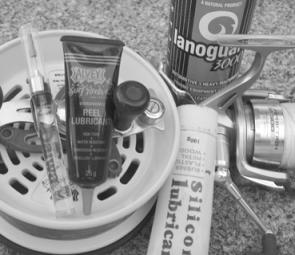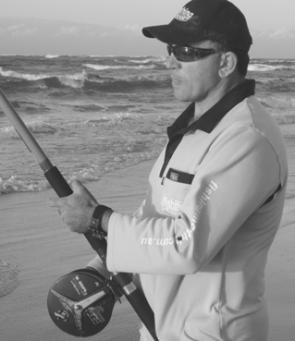In my master plan for this series, I wanted to include a tackle maintenance section because fishing the surf is so gruelling on tackle.
I can tell you all about repairing Alveys as most just need a simple washer replacement but getting into overheads and even threadlines, I needed to do some homework and chat to a few mates to get the basics of good surf tackle maintenance.
Alveys are generally easy. The simple center pin reel with no gearing or drags needs to have a couple of washers replaced every year or so. Put the reel back together with a dab of petroleum jelly and it’ll be like new.
The washers that need regular replacement are the spindle fibre washer, spindle D washer and the nitrile washer. These washers, the locking nut and spring are all available in a little tune up kit; so call into an Alvey dealer, tell them the reel model and they should be able to order it in for you.
Geared models and the reels that have the lever drag seem are a little more complicated, but once they have been opened up, the reels are still very simple, requiring the same sort of care as the standard models.
Don’t forget to grease up the pins on the handles as well as the release mechanism for turning the reel for casting.
I have grouped these two together because what I need to say about one, I also need to mention when talking about the other.
The first thing you need to do every time you have finished with the reel in the surf is to ensure that it is washed. The best way to do this is to take the reel off the rod and wash it in some warm soapy water. Just use a sponge and wipe the reel as you squeeze water onto it. If you’re in a hurry, or if you are like me and get a little lazy from time to time, spraying the reel with a hose is fine but it isn’t as effective as the warm soapy water. If you do choose to use a hose, ensure that the setting on the nozzle is fine jet so you don’t push water and grip inside the reel. It’s also a good idea to have the reel’s drag locked tight to help avoid any nasties getting into the drag washers.
A good wash after every trip needs to be backed up with a regular grease and oil change. I want to stress here that my entire experience with maintaining reels has been nothing more than tinkering with my own reels in my garage; and I’m not able to give you a run down on your own reel. You need to be confident in removing a few screws here and there and if not, I suggest you leave it to the experts to look after. There should be a diagram of the reel parts in the reel’s box which may help you locate sprung parts that can get you into trouble.
One tip that John Softly gave in his reel maintenance articles was to remove sprung parts, or in this case even parts that you think are sprung, into a plastic bag so that you are not on your hands and knees for 25 minutes trying to find a tiny little spring.
If you feel comfortable enough to take the side plate off the reel and remove a few parts for cleaning and oiling, you will require a tray for parts cleaning and a collection of various oils and greases that will have the reel working like new again.
With the parts that I take from my reels, I like to give them a good soak and wash in a tub of kero. Use a toothbrush if you need to, but a soak in kero and a wipe with a rag gets just about everything cleaned up.
Always use proper reel oil to lube the bearings with. You can play around with viscosities if doing long distance casting with overhead reels but, generally speaking, all reel manufactures have oils that are prefect for both threadlines and overhead reels. My preferred reel oil is one made by Diawa that comes in a syringe type applicator that is simple and quick.
Getting the oil right in the bearing of an overhead is a must for distance casting as well as keeping the dreaded birds nests away. Most casting problems are from poor technique or a bad balance between the rod, line class and reel so don’t blame all your overhead casting difficulties on the oil, however getting it right makes a huge difference.
The trick with getting overhead reel bearing oil right is in the viscosity of the oil. If the drum of the reel is spinning too fast, the oil may be too light, needing to be replaced with the slightly thicker oil. You can experiment with this at home or get onto the Fishing Monthly website and talk to John Softly about it. Getting the oil right means you can start taking the preload off the reels bearings all together, forgetting all about those little adjustments on the side of the reel.
For lubing the gears of my reels I turn to Penn’s blue grease, but I have seen plenty of similar greases on the market. Just a light covering over the gears is all that is needed every few months to keep everything in top shape. Always clean the old grease out of the reel before lubing with the fresh stuff otherwise you wind up with grease in all corners of the reel.
Drag washers need a lubricant of their own and it’s vital that the right drag grease be purchased for the reel. Most reels will take standard quality drag grease but there are also some that need there own special lube as well as other drag systems that are meant to be run dry. Just a drop or two smeared over the surface of the washer or between the layers of the multi-washer systems is all you need. When you buy reel, check and see if it requires drag oil. If it does, ask the salesmen if it is available.
Most rod runners are made of rustable metal that also needs to be washed down at the end of the day. It also pays to have the reel removed from the reel seat, especially if the reel isn’t being used very often.
A good tip for checking the runners of any rod is to pinch some old pantyhose and run that through the guides. The fine nylon will quickly catch on anything that is sticking out from the runners that could damage your fishing line.
Fishing line needs to be kept out of the sun when not in use. Keeping rods stored on bullbars even for a few hours at a time will heat up the nylon and damage the line.
Maintaining rods, line and reels makes fishing a lot more enjoyable. If you have ever lost a big fish to a dodgy knot, poor tackle or something else that you just didn’t put enough care and effort into, you will know that maintenance and preparation is vital to success.
Reads: 6388
Maintaining your tackle isn’t difficult; it’s just a little time consuming. Learn to do it right or get your reels to an experienced reel servicer at your local tackle shop.

Alvey reels are the simplest to maintain as all you need to do is replace washers every so often.

Threadline reels can be difficult to service, but do it regularly and your reel will last longer and your fishing will be more pleasurable.




